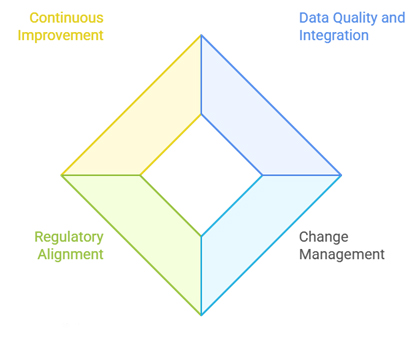Efficient and compliant case intake is the backbone of modern pharmacovigilance. As the pharmaceutical industry faces escalating data volumes, complex global regulations, and mounting cost pressures, automation of case intake is emerging as a strategic imperative. This guide examines the tools, processes, challenges, and return on investment (ROI) associated with automating pharmacovigilance case intake—equipping pharmaceutical leaders with the knowledge to drive operational transformation, enhance patient safety, and explore expert PV Consulting Services to ensure successful implementation and compliance.
What Is Case Intake in Pharmacovigilance and Why Automate It?
Case intake is the process of collecting, validating, and entering adverse event (AE) reports into a pharmacovigilance system. These reports come from a variety of sources—healthcare professionals, patients, literature, digital platforms, and call centers. Traditionally, this has been a manual process involving significant time, resources, and risk of error.
Why Is Case Intake So Important?
- First Line of Defense: It ensures that every potential safety issue is captured and evaluated.
- Regulatory Compliance: Timely and accurate case intake is required by regulatory agencies worldwide.
- Data Quality: The accuracy of intake impacts downstream safety analysis and reporting.
- Patient Safety: Early detection of safety signals can prevent harm and save lives.
Key Drivers for Automating Case Intake
- Rising Case Volumes: With more drugs on the market and greater awareness, the number of AE reports is growing rapidly.
- Complex Data Sources: Reports arrive in various formats—emails, PDFs, scanned documents, phone transcriptions, and social media posts.
- Regulatory Pressure: Agencies like the FDA and EMA demand timely, accurate, and traceable reporting.
- Resource Constraints: Manual intake is labor-intensive and diverts skilled staff from higher-value scientific tasks.
How Automation Transforms Pharmacovigilance Case Intake
Traditional Case Intake Process
- Manual data extraction from emails, forms, and call logs
- Data entry into safety databases
- Triage and assignment to safety reviewers
- Initial quality checks for completeness and compliance
This approach is slow, costly, and susceptible to human error.
Automated Case Intake Workflow
Modern automation platforms leverage artificial intelligence (AI), machine learning (ML), and natural language processing (NLP) to revolutionize intake:
Multi-Channel Data Capture
- Automated systems monitor emails, call centers, online portals, and messaging bots for incoming AE reports.
- AI extracts structured data from unstructured sources, including PDFs, scanned documents, and free-text emails, ensuring that nothing is missed.
Intelligent Data Extraction and Validation
- NLP algorithms interpret medical language, identify key data fields, and auto-populate safety databases.
- Built-in validation tools check for completeness, accuracy, and regulatory compliance.
Automated Triage and Assignment
- AI assesses the seriousness, validity, and urgency of cases, routing them to the appropriate reviewers based on preset rules.
- Duplicate reports are detected and flagged to reduce redundant work.
Seamless Integration and Workflow Orchestration
- Automated platforms connect with safety databases, regulatory systems, and clinical platforms to enable end-to-end workflow management.
- Real-time dashboards provide visibility into case status, bottlenecks, and compliance metrics.
Continuous Learning and Improvement
- Machine learning models improve over time, adapting to new case types, languages, and reporting formats.
- Feedback loops allow ongoing optimization of automation rules and processes.
Leading Tools for Automating Pharmacovigilance Case Intake
The market for pharmacovigilance automation is rapidly expanding, with several robust solutions available. Key features to look for include:
- AI/ML/NLP-powered intake with multi-channel data capture
- SaaS-based, cloud-enabled solutions for scalability and remote access
- Intelligent triage and customizable workflows
- Real-time dashboards and analytics for compliance monitoring
- Integration with safety databases, regulatory portals, and EHRs
- Multilingual support for global operations
Popular platforms (as examples) include solutions from IQVIA, Automation Anywhere, WinWire, PubHive, UBC, Clinevo, and AiRo Labs. Each offers unique strengths in terms of data capture, workflow automation, and compliance.
Step-by-Step Business Process of Automated Case Intake
Step 1: Intake Channel Monitoring
- Systems continuously scan all intake channels (email, web forms, call centers, apps, literature, and social media) for new cases.
- AI bots can interact with reporters via chat or messaging apps, guiding them through structured reporting.
Step 2: Data Extraction and Standardization
- NLP extracts relevant information (patient details, drug, event, outcome, reporter info) from free text and attachments.
- Data is standardized to regulatory formats (e.g., MedWatch, CIOMS, E2B(R3)).
Step 3: Case Validation and De-duplication
- Automated checks ensure all required fields are present and valid.
- Duplicate reports are detected and merged, preventing redundant processing.
Step 4: Automated Triage and Prioritization
- AI assesses case seriousness and urgency, auto-assigning to appropriate teams or escalating as needed.
- Rules can be customized for product lines, regions, or regulatory requirements.
Step 5: Database Entry and Workflow Integration
- Data is entered into the safety database with full audit trails.
- Cases are seamlessly routed to downstream processes (medical review, narrative generation, regulatory submission).
Step 6: Real-Time Monitoring and Reporting
- Dashboards track intake volumes, processing times, compliance status, and late case alerts.
- Analytics identify bottlenecks and opportunities for further automation.
ROI: The Business Case for Automation in Pharmacovigilance
Quantifiable Benefits
- Cost Reduction: Automation can lower case intake and triage costs by 40-60%.
- Time Savings: Processing time per case drops by 40-50%, with some platforms reporting up to 20 minutes saved per case.
- Resource Optimization: Highly skilled PV professionals can focus on scientific assessment, signal detection, and risk management rather than repetitive data entry.
- Compliance Improvement: Automated validation and audit trails reduce compliance risk and improve readiness for regulatory inspections.
- Scalability: Automation easily accommodates spikes in case volume, supporting global product launches and crisis events.
Strategic Value
- Enhanced Patient Safety: Faster, more accurate intake means quicker detection and response to emerging safety signals.
- Competitive Advantage: Early adopters of automation can scale PV operations efficiently and adapt to evolving regulatory landscapes.
- Global Harmonization: Automated systems support multi-language, multi-region intake, ensuring consistent quality worldwide.
Real-World Example
A global pharmaceutical company implemented multilingual case intake automation, reducing manual processing time by 50% and increasing responsiveness to drug safety issues. This not only improved operational efficiency but also enhanced their ability to meet global regulatory requirements and protect patient safety.
Challenges and Best Practices for Implementing Automation

Data Quality and Integration
- Challenge: Source data may be incomplete, unstructured, or incompatible with automation tools.
- Best Practice: Invest in data standardization and ensure robust integration with existing PV databases and IT infrastructure.
Change Management
- Challenge: Staff may be resistant to new workflows or fear job displacement.
- Best Practice: Train staff to work alongside AI-driven systems, emphasizing that automation frees them for higher-value work.
Regulatory Alignment
- Challenge: Automation must comply with evolving global regulations (ICH, FDA, EMA, ISO).
- Best Practice: Select platforms that are regularly updated to meet international standards and provide transparent audit trails.
Continuous Improvement
- Challenge: AI models and workflows can become outdated as regulations and case types evolve.
- Best Practice: Regularly review automation performance, update rules and algorithms, and gather user feedback for ongoing optimization.
Future Trends in Pharmacovigilance Case Intake Automation
AI-Driven End-to-End Workflow Automation
- AI agents will manage intake through regulatory submission and signal detection.
- Real-time monitoring and adaptive learning will enhance safety surveillance.
Enhanced Interoperability
- Integration with electronic health records (EHRs), clinical trial systems, and regulatory portals will become standard.
- Breaking down data silos will enable comprehensive drug safety management.
Patient-Centric Reporting Solutions
- Increasing use of apps, chatbots, and social media channels for direct patient AE reporting.
- AI will ensure data quality and compliance from the first point of contact.
Predictive Analytics and Proactive Safety
- Automation will enable predictive analytics, identifying potential safety issues before they escalate.
- Proactive safety measures can be implemented earlier, reducing risk to patients and companies alike.
Conclusion: The Future of Pharmacovigilance Starts with Automated Case Intake
As the pharmaceutical industry navigates rising safety data volumes and tightening regulatory landscapes, automating case intake is no longer a luxury—it’s a necessity. By leveraging AI, NLP, and intelligent workflow orchestration, organizations can transform pharmacovigilance from a reactive, manual process into a proactive, streamlined operation.
The result? Faster case processing, improved compliance, optimized resource utilization, and—most importantly—enhanced patient safety. Early adopters are already seeing significant ROI, and as automation technologies continue to evolve, the gap between manual and automated pharmacovigilance operations will only widen.
For pharma leaders, the path forward is clear: embrace automation to future-proof your safety operations, drive efficiency, and fulfill your ultimate mission of protecting patients worldwide.

